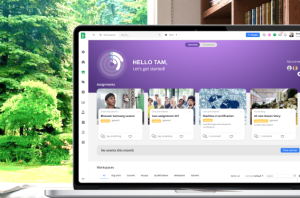The way we work and learn is changing at speed. Job skill requirements have shifted by around 25% since 2015, and by 2028, employers predict that 44% of workers’ skills will be disrupted. With technological advancements and remote or hybrid work setups, businesses and their people must navigate constant change and adaptability, which is why investing in improving your employee learning potential is so important.
Soft skills such as learning potential, resilience, and communication are anything but light in impact. With almost two-thirds of companies concerned about labour shortages in 2024 and beyond, these soft skills are a strategic asset for businesses, enabling them to adapt, collaborate, innovate, and retain talent more effectively.
Investing in employees with high learning potential can future-proof your workforce. Explore why this soft skill is a super skill that should take centre stage in your L&D strategy.
What is employee learning potential?
Put simply, learning potential is about a person’s ability and readiness to learn, develop, and adjust to new knowledge, technologies, and workplaces. It represents how much someone can learn given the right conditions, support, and resources.
Learning potential depends on intelligence, cognitive abilities, motivation, prior knowledge, learning styles, and environmental factors. It’s a crucial skill that helps employees and organisations succeed in a world of constant change.
The limitations of personal growth
A lack of growth potential can have significant implications for employees and employers.
For employees, it means fewer opportunities for career advancement and personal development. They may feel stuck in their existing roles, leading to frustration, disengagement, and decreased job satisfaction. Without the chance to learn and grow, employees can become stagnant in their skills, making them less competitive in the job market or stuck in a job they don’t like.
This focus on development becomes even more critical in light of Gallup’s State of the Global Workplace 2023 Report, which found that more than three-quarters (77%) are disengaged from their work. To make matters worse, 18% are actively disengaged, showing no interest in reaching their full potential.
For employers, limited growth potential can lead to higher turnover rates and difficulty retaining top talent. When employees feel there are no opportunities for advancement with their current employer, they are more likely to leave for better prospects. This turnover can be costly, with time and effort spent hiring new employees and losing valuable knowledge. It’s no surprise that helping employees develop their careers has become increasingly important, rising from ninth to fourth place on L&D’s priority list.
Consider a scenario where a machine operator working in a manufacturing role sees limited opportunities for promotion or skills development. Without the chance to expand their skill set or take on new challenges, such as management roles, they feel unfulfilled and unmotivated. As a result, job satisfaction decreases, leading them to consider seeking employment elsewhere.
Frequent turnover of machine operators can disrupt operations. New employees need training and time to become as productive as their predecessors. This learning period can slow production, cause order fulfillment delays, and affect customer satisfaction. Also, inconsistent staffing can lead to more equipment malfunctions if new operators are not yet familiar with the machinery.
The benefits of employee learning potential
While hard skills are essential for specific job roles such as accountancy and IT, soft skills, like learning capabilities, are crucial in any work environment.
Assessing and investing in employees’ learning potential improves their performance and creates a dynamic, creative, and efficient workplace. Recognising an employee’s growth potential can bring significant benefits.
Increased adaptability
Some 73% of employees affected by change say they’re suffering from moderate to high stress levels. This highlights the need for strong adaptability skills to manage stress and remain productive during transitions.
Since employees with learning potential are continuous learners, they take personal responsibility for seeking new opportunities to build skills and knowledge. By actively looking for chances to learn and improve their skills, they quickly learn how to use new software or digital tools for their jobs, showing they can adapt, pick up new skills quickly, and acquire new competencies.
Training employees to be flexible and resilient can help them cope better with changes, reduce stress, and maintain overall well-being.
Software such as Blossom can empower and engage your employees by providing them with an interactive and intuitive platform for skill development. With its user-friendly interface and personalised portals, Blossom ensures that everyone, from frontline workers to the C-suite, can easily access relevant information and courses tailored to their roles and locations. This accessibility allows employees to engage with learning opportunities, such as stress management, supporting their learning potential.
Take it from Maya Gutman, Learning & Development Team at Micro Focus, who says, “Blossom’s platform is highly functional. It interfaces with email, so employees can receive training invitations and sign up for courses directly via their inbox. The UX is visually appealing and accessible, which is well suited to the hi-tech culture of our organisation.”
Improved efficiency
Employees with high learning potential are cross-functional team players. By seamlessly transitioning between different departments or roles within the organisation, they showcase their ability to adapt to new work environments and responsibilities. These individuals consistently contribute creative solutions to challenges or propose novel ideas for improvement to demonstrate their capacity for learning and innovation.
Quicker problem-solving means less time spent on addressing issues, allowing resources to be allocated more effectively and increasing overall productivity. With less time spent on fixing problems, the organisation can focus more on strategic goals.
Let’s say a nurse with high learning potential quickly implements new medical procedures. By seamlessly moving between departments, such as emergency and intensive care, they help solve staffing issues and improve patient care efficiency. Their ability to propose new ways to streamline patient intake processes demonstrates their innovative approach to problem-solving. This increases their job satisfaction and reduces the potential for issues to escalate.
Create a community where everyone can learn from each other, share insights, and collectively contribute to the learning culture within your organisation. By leveraging tools and platforms, such as Blossom, that facilitate knowledge-sharing and internal communications, you can empower employees to continuously learn, grow, and solve problems.
Reduce employee turnover
Employee turnover is when employees leave voluntarily, of their own accord, or involuntarily due to poor performance, redundancy, or organisational changes. With about a third of UK workers leaving their jobs each year, the impact on both individuals and businesses is considerable:
For employees:
- Disruption to career stability and continuity
- Potential loss of benefits and seniority. For example, workers may lose accrued benefits such as paid time off, retirement contributions, and healthcare benefits
- Emotional stress and uncertainty during job transitions
For employers:
- Increased recruitment, training, and onboarding costs
- Decreased productivity and morale among remaining employees, particularly when those remaining are burdened with more work
- High turnover can harm a company’s reputation, raising doubts about its stability and management practices
That said, employee turnover is normal and essential as careers, markets, and personal circumstances change and businesses evolve. If a company kept the same staff forever, it wouldn’t be able to adapt and grow.
When companies prioritise retaining employees to minimise turnover, they keep their workforce stable and create an environment where individuals are encouraged to enhance their learning potential. When employees see that the company values their growth and development, they are more likely to feel aligned with its values and goals. This alignment can foster a sense of belonging and reduce turnover rates.
Flexible thinking
Individuals with learning potential can adapt to changes, such as new working conditions and environments, with greater ease and effectiveness. For instance, they successfully transition to remote or hybrid work setups, using new communication and collaboration tools best and demonstrating adaptability and willingness to learn in changing environments.
Flexible employees are open to learning new things and exploring different methods. They’re willing to step out of their comfort zones, which helps them gain diverse skills and knowledge, boosting their confidence and success.
What’s more, companies with a high proportion of flexible employees can become hubs of innovation driven by grassroots efforts. These employees actively try new ideas and technologies, igniting innovation within the company.
Greater flexibility
The most recent ONS data shows that the percentage of employed people aged 65 and older has nearly doubled since records began.
With an aging population, a growing segment of older workers may need to learn new skills to stay employable. For example, when suddenly faced with a new learning experience platform, having the ability to learn quickly helps them not only to be excited about trying it out but also find their way around new technology faster, making sure they can still do their job well.
Consequently, older workers today are just as likely to have qualifications as their younger colleagues. This shift means that learning potential is not limited by age but is instead a valuable asset for individuals of all ages in the workforce.
This change has profound implications for how companies think about and use their workforce. Previously, there may have been assumptions that older workers were less adaptable or resistant to learning new skills than younger employees.
The reality is quite the opposite. Older workers bring a wealth of experience, wisdom, and a strong work ethic to the table. When it comes to learning potential, older workers can adapt to changing job requirements, switch careers if necessary, and maintain their productivity in the workforce.
Increased innovation and creativity
Staff members who take a proactive approach to personal development view obstacles with curiosity and determination.
Rather than feeling discouraged by setbacks, they see them as chances to expand their skills, knowledge, and resilience. For example, if they face difficulties in mastering a piece of new machinery, they embrace the opportunity to improve their problem-solving and communication skills instead of giving up.
Here’s what we mean.
Consider Rifat, a marketing department employee. Rifat has always been curious about data analysis but has lacked opportunities to explore it thoroughly. Recently, the company introduced new data analytics software and offered training sessions for interested employees.
Recognising this chance to expand her skills, Rifat eagerly attended the training and began experimenting with the software independently. Her curiosity grew as she delved deeper into data analysis, prompting her to ask more questions and seek additional resources.
Rifat’s growing curiosity led her to apply her new skills to marketing projects. This helped uncover previously unnoticed patterns in consumer behaviour. By analysing this data, she identified a segment of customers who were highly engaged with the company’s products but had low sales figures.
Increased employee engagement
Gone are the days when employees were just interested in pay and benefits. Today’s workers seek job opportunities that offer financial rewards, provide a path for personal and professional growth, and provide a sense of achievement and satisfaction.
When it comes to learning potential, building a culture that values continuous learning and development can significantly enhance employee engagement. This can be achieved through:
- Offering teamwork and knowledge-sharing opportunities. When people feel connected to their colleagues, they are more likely to engage in open dialogue, exchange ideas, and seek help when needed. Building a community enhances learning potential by providing opportunities for employees to learn from one another’s experiences, perspectives, and expertise.
- Access to expertise. Employees are more inclined to seek peer mentorship and guidance within a supportive community. Mentoring relationships can significantly facilitate learning and professional development, as experienced employees share their insights and advice with those newer to the organisation or role. This peer support network enhances learning potential by providing workers access to valuable resources and guidance.
- Providing learning resources and tools. Giving employees access to relevant learning materials, online courses, workshops, and training sessions encourages self-directed learning. By empowering employees to take ownership of their development, workers can explore topics of interest aligned with their goals and acquire new skills at their own pace.
Tap into internal and external talent
While experience and qualifications provide a foundation, candidates’ eagerness to learn and adapt can significantly impact their success.
However, despite companies heavily investing in recruiting top talent, they often overlook the importance of learning potential. There’s a widespread belief that exceptional hires will immediately excel without much additional support, but this isn’t the case.
Instead of solely focusing on qualifications or experience, seek individuals who demonstrate readiness to grow and develop in the role. This widens the pool of potential hires, allowing for diverse talents and perspectives. By blending current team members’ strengths with new hires’ fresh perspectives with learning potential, companies can cultivate an environment where innovation flourishes, collaboration thrives, and success becomes a shared journey.
Create a culture where existing employees are also encouraged to evolve. Internal mobility and opportunities for growth are crucial for employee satisfaction and retention. Employees who see pathways for advancement and development are more likely to stay engaged and committed to their roles.
Unlock endless possibilities with Blossom
Learning potential isn’t just a soft skill; it’s a super skill. When individuals take charge of their personal growth and have employers who provide proactive, inspiring training, organisations can adapt, flourish, and succeed despite uncertainty, surpassing those with narrower skill sets and mindsets.
This capacity and eagerness to learn, develop, and adapt empowers your team to embrace new challenges and opportunities and achieve success by tapping into their limitless potential.
Invest in your employees’ learning potential with Blossom and build a work environment primed for innovation, resilience, and long-term success. Schedule a demo with one of our friendly experts today.








